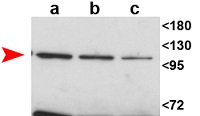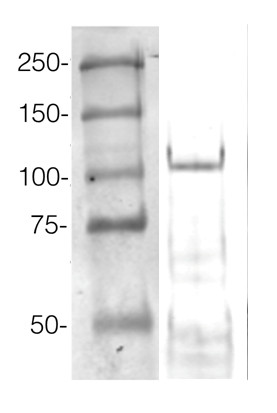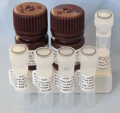1

Anti-AGO10 | Argonaute 10
AS15 3071 | Clonality: Polyclonal | Host: Rabbit | Reactivity: Arabidopsis thaliana
- Product Info
-
Immunogen: KLH-conjugated synthetic peptide derived from Arabidopsis thaliana AGO10 protein sequence, Uniprot: Q9XGW1, TAIR: AT5G43810
Host: Rabbit Clonality: Polyclonal Purity: Immunogen affinity purified serum in PBS pH 7.4. Format: Lyophilized Quantity: 50 µg Reconstitution: For reconstitution add 50 µl of sterile water Storage: Store lyophilized/reconstituted at -20°C; once reconstituted make aliquots to avoid repeated freeze-thaw cycles. Please remember to spin the tubes briefly prior to opening them to avoid any losses that might occur from material adhering to the cap or sides of the tube. Tested applications: Western blot (WB) Recommended dilution: 1 : 10 000 (WB) Expected | apparent MW: 110.9 kDa - Reactivity
-
Confirmed reactivity: Arabidopsis thaliana Predicted reactivity: A. lyrata, B. napus, C. rubella, C. clementina, C. sinensis, E. salsugineum, G. arboreum, G. raimondii. M. truncatula, N. benthamiana, Poplar sp.
Species of your interest not listed? Contact usNot reactive in: Zea mays
- Application Examples
-
Application example 
50 µg of total protein from Arabidopsis thaliana inflorescences were extracted with extraction buffer (50 mM Tris pH7.5; 150 mM NaCl; 1 mM EDTA; 10 % v/v Glycerin; 1 mM DTT, 1x Complete Protease Inhibitor Cocktail, Roche) and denatured with Laemmli buffer at 95ºC 5 min. were separated on 10% SDS-PAGE and blotted 1.5 h to PVDF using tank transfer. Blots were blocked with blocking buffer (3% milk powder; 1x TBS; 0.1% Tween-20) 1 h at RT with agitation. Blot was incubated in the primary antibody at a dilution of 1:10 000 ON at 4ºC with agitation. The antibody solution was decanted and the blot was rinsed briefly and then washed tree times for 15 min. in TBS-T at RT with agitation. Blot was incubated in secondary antibody (anti-rabbit IgG horse radish peroxidase conjugated, from Agrisera AS09 602) diluted to 1:20 000 in blocking buffer for 1h at RT with agitation. The blot was washed as above and developed for 5 min with chemiluminescent detection reagent of extreme femtogram sensitivity, exposed to Amersham Hyperfilms ECL for 5 minutes. ago10-2 mutant is described here.
Courtesy of Dr. Dr. Pablo Manavella, Instituto de Agrobiotecnología del Litoral (IAL), Argentina - Additional Information
-
Additional information (application): AGO expression may be cell/tissue specific and using floral tissue is recommended where most of the AGOs are expressed the highest. Seedlings can be used as a negative control.
Use of proteasome inhibitors as MG132 can help to stabilize AGO proteins during extraction procedure. - Background
-
Background: AGO10 is involved in miRNA binding, and in RNA-mediated posttranscriptional gene silencing (PTGS).
- Product Citations
-
Selected references: Sun et al. (2021) The epigenetic factor FVE orchestrates cytoplasmic SGS3-DRB4-DCL4 activities to promote transgene silencing in Arabidopsis. Sci Adv. 2021 Aug 4;7(32):eabf3898. doi: 10.1126/sciadv.abf3898. PMID: 34348894; PMCID: PMC8336953.
Oliver & Martinez. (2021) Accumulation dynamics of ARGONAUTE proteins during meiosis in Arabidopsis. Plant Reprod. 2021 Nov 23. doi: 10.1007/s00497-021-00434-z. Epub ahead of print. PMID: 34812935.
Sprunck et al. (2019). Elucidating small RNA pathways in Arabidopsis thaliana egg cells. - Protocols
-
TCA/Acetone protein precipitation method for plant proteins
- Grind plant tissue in a liquid nitrogen.
- Continue grinding with 10% TCA solution in acetone (ice cold).
- Precipitate overnight in -20C.
- Spin at 4°C for 1min, 17k rpm > wash with ice cold acetone until you obtain a white pellet.
- Dissolve the pellet in buffer of choice (for example 8M urea containing 5mM DTT, or denaturate in SDS protein loading buffer for 10 min. at 70°C)
- Clarify supernatant
- Measure protein concentration.
- Proceed with a western blot.
Example of a western blot result obtained with this method, which allows high protein load per well, can be found below.

360 µg/well of Arabidopsis thaliana protein extracted by TCA-acetone precipitation from floral tissue and saturated in 8M urea were separated on 15% SDS-PAGE and blotted for 1hour to 0.2 µm nitrocellulose at 100V using wet transfer system. Blots were blocked with 0.5% cold fish gelatin for 1hr at room temp with agitation. Blot was incubated in the primary antibody at a dilution of 1:2500 for an hour at RT with agitation. The blots were washed with 3X 15min TBS-TT at RT with agitation. Blots as incubated in the secondary antibody (DayLight 800) 1:5000 dilution for 30 min. at RT with agitation and washed 1X with TBSTT for 15 min, 1X with TBST for 15min before scanning with the ODyssey IRD scanner.
Courtesy of Dr. Betty Chung and Pawel Baster, University of Cambridge, United Kingdom
BACK to Plant Protocols page - Reviews:
-
This product doesn't have any reviews.
Accessories

This set contains:
- 4 Anti-AGO antibodies of your choice, chosen from a drop down menu below
- Matching secondary antibody, HRP conjugated, min. 1: 25 000, 1h/RT (AS09 602 - trial)

